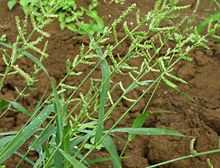Echinochloa colona
From Wikipedia, the free encyclopedia
| Echinochloa colona | |
|---|---|
 | |
| Scientific classification | |
| Kingdom: | Plantae |
| (unranked): | Angiosperms |
| (unranked): | Monocots |
| (unranked): | Commelinids |
| Order: | Poales |
| Family: | Poaceae |
| Subfamily: | Panicoideae |
| Genus: | Echinochloa |
| Species: | E. colona |
| Binomial name | |
| Echinochloa colona (L.) Link | |
| Synonyms | |
| |
Echinochloa colona is a type of wild grass originating from tropical Asia. It was formerly classified as a species of Panicum. It is the wild ancestor of the cultivated cereal crop Echinochloa frumentacea, sawa millet.[1] Some taxonomists treat the two taxa as one species, in which case the domesticated forms may also be referred to as E. colona.
Distribution and habitat
The grass occurs throughout tropical Asia and Africa in fields and along roadsides. It is naturalized in North America.[2]
In culinary use
In India seeds of this grass are used to prepare a food dish called khichadi [3]and are consumed during festival fasting days. In Gujarati is called "Samo" (સામો) or "Moriyo" (મોરિયો) in Marathi it is called 'bhagar' or "Vari cha Tandul" (वरी चा तांदुळ).
References
- ↑ Hilu, Khidir W. (1994). "Evidence from RAPD markers in the evolution of Echinochloa millets (Poaceae)". Plant Systematics and Evolution 189 (3): 247–257. doi:10.1007/BF00939730.
- ↑ "Echinochloa colona". Natural Resources Conservation Service PLANTS Database. USDA. Retrieved 8 April 2013.
- ↑
External links
- Echinochloa colona. UC Davis IPM.
This article is issued from Wikipedia. The text is available under the Creative Commons Attribution/Share Alike; additional terms may apply for the media files.